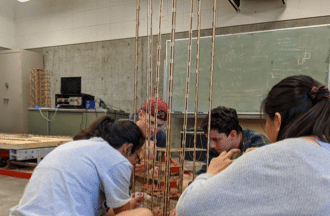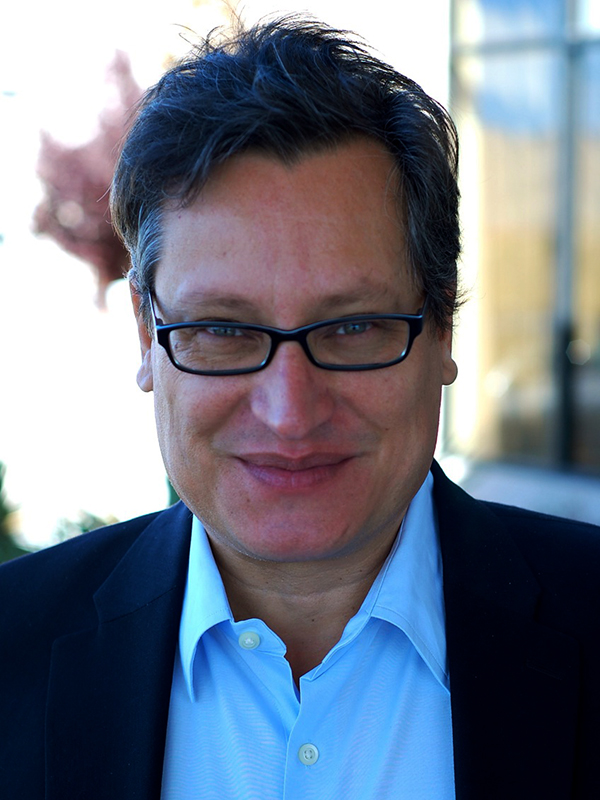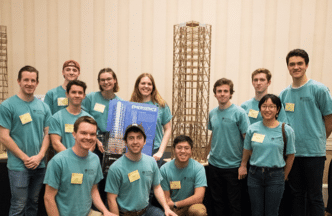ACSA Announces Annual Meeting Best Paper and Best Project Awards
ACSA is pleased to announce the creation of new annual awards for the ACSA Annual Meeting. The awards program, which was initiated by the ACSA College of Distinguished Professors, will promote research, scholarship, and creative excellence by recognizing a Best Paper and Best Project presented at the ACSA Annual Meeting.
University at Buffalo, SUNY
UB Department of Architecture – ACSA news – May, 2020.
Assistant Professor Charles Davis was a co-editor of the book ‘Race and Modern Architecture: A Critical History from the Enlightenment to the Present’. The book was recently published by the University of Pittsburgh Press.
Associate Professor Joyce Hwang and her collaborator UT Austin Assistant Professor Nerea Feliz, published ‘Hidden in Plain Sight’ – their project for Matadero, Madrid, – in Ground Up, the journal of the Department of Landscape Architecture and Environmental Planning at UC Berkeley.
Professor Brian Carter’s notes on Louis Kahn’s Tribune Review Building were published by Drawing Matter in May,2020 (http://www.drawingmatter.org/sets/drawing-werek/kahn-note-scrap-paper)
Assistant Professor Nicholas Rajkovich was promoted to the rank of Associate Professor with tenure. Professor Rajkovich’s research focuses on climate change and he played a leading role in the design of UB’s Grow Home that received an award in the US Dept. of Energy 2015 Solar Decathlon International Design Competition.
May 26, 2020
Pennsylvania State University
UNIVERSITY PARK, Pa. — After nearly 18 months of planning, several production hurdles and a worldwide pandemic that shut down international travel, not to mention all of Italy, architect and 2007 Penn State alumna Gillean Denny and a group of students, faculty and research assistants in the Stuckeman School are celebrating the virtual unveiling of a “Living Chapel” they designed to promote environmental consciousness as part of Global Catholic Climate Movement (GCCM) activities in Rome from May 16-24, and the United Nations (U.N.) World Environment Day on June 5.
Musician Julian Revie, Denny’s longtime friend and the associate director of music at the Center for Music and Liturgy of Saint Thomas More Chapel at Yale University, was the catalyst for the project. Inspired by the U.N.’s 2030 sustainable development agenda and “Laudato Si” — the 2015 papal encyclical on climate change — Revie worked diligently with Vatican officials to get the plans for the chapel approved and the structure installed.
“The chapel is an instrument to inspire a sense of serenity and oneness with nature in those who pass through it,” explained Revie, who was the recipient of the Vatican’s 2016 Francesco Siciliani prize for a sacred music composition.
The purpose of the chapel is “to encourage worldwide acts of ecological restoration with an emphasis on tree planting in support of the U.N.’s Trillion Tree Campaign,” said Denny, who earned a bachelor of architecture from the Stuckeman School.
The structure, which features green walls that are adorned with living plants and an elaborate chime wall featuring metal embellishments, will officially be introduced via streaming video on June 5 in the Rome Botanical Garden as part of events organized by the Italian Alliance for Sustainable Development (ASviS) in celebration of the U.N.’s World Environment Day.
The chapel will eventually be on display at the Vatican, where it will become the second structure in Vatican City to be designed by an American architect. The first was the Chapel of the Holy Spirit by architect Louis Astorino, also a Penn State architecture alumnus.
From the Vatican, the Living Chapel will move to its permanent home in Assisi, Italy, as a feature point of a new Saint Francis pilgrimage trail that is being unveiled this spring by the GCCM.
The massive structure, which measures 45 feet long by 30 feet wide with walls that range from 10 to 15 feet high, was built out of aluminum and recycled and repurposed materials on the University Park campus during the latter part of the fall 2019 semester and the early weeks of the spring 2020 semester. It was then shipped to Rome, where it was put into storage while travel restrictions were enacted and the country went into lockdown. At that point, Revie and Denny reevaluated their plans from their respective homes in New Haven, Connecticut, and Toronto, Canada.
But how did such an elaborate project for the Vatican and the U.N. come about in the first place?
The friendship and the idea
Revie and Denny met while they were both attending graduate school at the University of Cambridge. The friends became housemates during their time in the U.K., with Revie introducing Denny to her now-husband, and they would often discuss the possibility of collaborating.
After graduating with a master of philosophy and doctorate from Cambridge, Denny became an educator and freelance designer for several years before reducing her professional commitments to start a family. Revie, meanwhile, composed two papal masses and served as a composer and professional organist in Los Angeles before moving on to Yale.
Revie had the initial idea of creating a chapel that could be designed to play a musical piece he would compose while furthering the conversation on climate change in time for the fifth anniversary of the pope’s Laudato Si. A member of the Catholic church, Revie also wanted to pay homage to St. Francis of Assisi, who is known in the faith for his love of nature.
After much discussion with members of the Vatican and theologians worldwide, Revie was frustrated by the lack of a single design vision for the chapel, which is when the idea of collaborating with Denny reemerged. As a fellow Catholic with a professional background in sustainable design, urban agriculture and theatre production, Denny seemed ideal to help solidify the chapel vision.
They decided to begin precisely as St. Francis did. “It is said that when Francis received a message from God to ‘go build a church,’ he took the directive literally and built a prayer chapel,” explained Revie. “We wanted to reimagine that structure.”
The church built by St. Francis — Porziuncola — still stands in Assisi and resides within the larger Basilica of Saint Mary of the Angels, which was built to accommodate the visitors that come to pay homage to the saint. The site has since been named a UNESCO World Heritage Site.
The vision for the Living Chapel took on a life of its own, and the scope was immense. The pair knew they needed help to pull it off.
“I was really intrigued by the idea [of the chapel], but I thought Julian was completely insane for wanting to have something of this scale finished by early 2020,” said Denny. “Then as we discussed it more and started fleshing out ideas, the less crazy it seemed and the more excited I got. There was a moment that I knew I wanted to be a part of this project, but I also knew that I could not design and build what we had in mind by myself.”
By then it was the spring of 2019 and Denny decided to seek assistance from the place that fueled her passion for design-build projects and Italian architecture.
A tradition of design-build
The Department of Architecture in the Stuckeman School at Penn State has a rich tradition of design-build curricula, beginning in the first year of the five-year professional bachelor of architecture program. Students learn the importance of not only designing a structure, but the physical process of putting together their design projects by hand, using real building materials. Traditionally, students in the fourth year of the program are required to study for a semester in Rome at the Pantheon Institute, where they experience firsthand the historic and contemporary architecture, landscape architecture and urbanism of the city.
James Kalsbeek, an associate professor in the department since 1990, specializes in leading design-build projects with students in both the first-year studio and a more advanced seminar where students work exclusively with discarded and reclaimed building materials. He also has been involved with the Rome program since its inception in 1991 and led the program in fall 2005 when Denny studied in Rome. Kalsbeek’s familiarity with design-build projects and Rome itself put him at the top of Denny’s list of people she wanted involved in the chapel project.
“I was thrilled when Gill called and explained what she was up to,” said Kalsbeek. “It was a huge undertaking, sure, but it was something I knew she was quite capable of doing because she had done it here as a student. Maybe not to the same scale, but it became sort of a running joke that she was an expert at designing and building structures that were made to end up somewhere else.”
Denny did her fair share of designing installations around campus during her time as an undergraduate, and more specifically, she had experience building green structures. Denny was the lead designer for the Penn State team that conceptualized the MorningStar solar home during her fourth year of studies. That structure was built on campus and shipped to Washington, D.C., for the 2007 Department of Energy Solar Decathlon. It was then on display in several locations before returning to its home on the University Park campus.
“Getting that hands-on experience — actually getting in there and touching the materials you are working with and seeing how they respond to each other and the elements — was something I got away from in my career with a family, so it was really exciting to get back out from behind a desk,” said Denny.
The structural frame
Denny and Revie presented their design ideas to Kalsbeek during the summer of 2019 with the understanding that this was a large-scale green project. It would need to be fabricated and assembled in a modular fashion at Penn State, then taken apart and shipped to Italy where it would be reassembled and covered with tree and plant saplings by Italian botanists at the Rome Botanical Garden.
Kalsbeek located a workspace large enough for their needs — the Laundry Building on campus — and assembled a “dream team” of students and researchers with expertise in building foundations, methods of assembly, fabrication processes, green structures and materials research that could work together to build the traveling, green, artistic, musical structure Revie and Denny envisioned.
That core team included architecture doctoral student Elizabeth Andrzejewski, graduate students Elizabeth Rothrock and Kacie Ward, and research assistants Becca Newburg, Garrett Socling and Dani Spewak, an alumna of the School of Visual Arts.
“I honestly didn’t think the project would come together given how short the timeframe was for all of the work that needed to get done, but I wanted to help,” said Andrzejewski, a skilled welder whose master’s thesis at Penn State was on jointing systems for prefabricated architecture and her doctoral research focuses on the interaction of materials and processes. “It seemed impossible, but given the significance, of course I wanted to do what I could to see it through.”
First up was tackling the chapel’s structural frame, which is where the team encountered one of its first production challenges.
“It was obvious right from the start that while Lizz (Andrzejewski) is an amazing welder, we only have one of her and we just knew that we didn’t have the resources here that we needed to fabricate a structure of this size,” said Ward. “We had to look elsewhere to get help.”
That “elsewhere” ended up being 60 miles away at the Pennsylvania College of Technology in Williamsport, which is known for its welding and metal fabrication programs.
Kalsbeek and Denny met with Penn College officials, including James N. Colton II, co-department head of welding and metal fabrication.
“Gillean came to our campus to meet with the team of faculty and students we assembled in September [2019] and we were asked if we could build the four walls for the chapel here,” said Colton. “We were talking about the materials we could use and decided that in order to keep the structure from getting too heavy, using aluminum was our best bet.”
In total, 4,956 feet of aluminum was used to construct the walls, which is about 16 football fields in length, and 3,514 combined hours were spent by the Penn College team on the project.
The work by the Penn College team was absolutely essential in getting the structural framework of the chapel built, said Denny.
“They literally were working miracles on that campus through Christmas break and into the new year,” she said. “But no way, no how, did the chapel get built without them. Period. They were amazing. Jim [Colton] and I were in constant contact every day, double-checking details as they worked and making changes as necessary.”
With the internal skeleton of the chapel completed and shipped to University Park in late January 2020, the Stuckeman School team got to work cladding the walls of the massive structure.
Building a musical, green chapel
Revie and Denny wanted to incorporate recycled and reusable materials into the chapel, so they started reaching out to friends and sharing details of their project in order to drum-up interest.
“One of my old Penn State friends has a connection we thought could help and long story short, that’s how we ended up getting more than 1,500 pounds of donated parts from two automotive metal stamping plants,” said Denny.
Revie also arranged for the donation of discarded oil drums and steel pan drums from a manufacturing plant. Each drum had a production flaw and would have been thrown out as scrap, yet they played beautifully.
With her strong welding background, Andrzejewski focused on the fabrication and mounting of steel pan drums from the donated parts on the chime wall, which was to be the chapel’s focal point. Newburg, a 2018 architecture alumna who has a background in fabrication, took interest in designing the series of drums that were to be part of Revie’s musical composition in the tradition of the instruments from the islands of Trinidad and Tobago. The drums are located inside the structural framework of the four walls. Newburg also worked with Denny to design the intricate metal screens of plants and suspended cross cutouts made from donated parts on the wall. Wind that flows through the chapel’s rolling layout will move the crosses to have a windchime effect while also reflecting light.
“When we had a good design [for the drums], we had to figure out how to make 37 of them that were rugged and durable so they would last,” she said. “At that point, we recruited 24 talented undergraduate architecture students to help and essentially set up a factory floor, explaining what they had to do at each station, so we could mass produce the pieces we needed.”
According to Kalsbeek, an additional eight students clocked dozens of hours on the CNC router in the Stuckeman Family Building, mass producing the custom-patterned metal panels with guidance from Jamie Heilman, the Stuckeman School’s digital fabrication and specialized technologies coordinator.
Meanwhile, Socling got to work designing the solar-powered irrigation system that circulates water through the green walls of the chapel. He also helped determine how the steel drums in the chapel framework would play.
“We have a frame around each drum that has brackets which hold a mallet that is positioned above the note on the drum it is to play,” explained Socling. “At the other end of the mallet, we fastened a 3D-printed cup that we made, which fills up with water from the irrigation system and brings the mallet down to strike the drum on the intended note while it empties with water into a cup with a mallet positioned on a specific note on the drum underneath it and so on.”
Rothrock, who graduated on May 9 with a master’s degree, is adept at understanding building materials and how they work with each other.
“Since our core team has a variety of research focuses, we were all able to benefit the design of the project in different ways,” said Rothrock. “We were all able to contribute our unique knowledge to the structure, which is why, I think, it is successful.”
Regrouping to bring the chapel ‘to life’
While the team from Penn State was set to travel to Rome to help Denny assemble the structure during spring break, with help from the fourth-year architecture students who were studying abroad at the Pantheon Institute, those plans were scrapped when the coronavirus pandemic erupted. The group needed to regroup and change course due to a hurdle no one could have predicted — a worldwide health crisis.
“We decided that to ensure everyone’s safety and to still meet the scheduled opening in mid-May, it was best to ask an Italian architecture firm to handle the assembly of the chapel,” said Denny.
Sequas, a Rome-based firm that was originally brought on to the project to verify the structural drawings for the chapel’s eventual installation in Assisi, handled the reassembly in the Rome Botanical Garden.
“Luckily, we designed and assembled the chapel in a modular fashion to begin with, so it is sort of meant to be taken apart and put back together without disrupting the systems,” said Andrzejewski.
The original plans for the chapel called for up to 10,000 saplings, cultivated from the Botanical Garden’s own trees and other participating nurseries, to be featured on or around the chapel. The idea was that the saplings would then grow enough to cover the structure by the time the chapel was unveiled.
Since those saplings continued growing while plans for the chapel were on hold as the COVID-19 pandemic surged, they are now too mature to install on the walls and are planted in pots throughout the chapel. Those trees will be distributed upon the chapel’s public opening to be planted in other parts of Italy where deforestation has taken place.
The green walls of the chapel are adorned with 3,000 perennial plants — a mix of evergreen leaves and flowers — that form a mosaic pattern. They are affixed to the walls with recycled fleece fabric that is stapled to PVC board. Other areas of the chapel also include trees and plants to reflect the rich biodiversity of Europe’s old growth forests, which have been almost entirely lost due to deforestation.
“The plants, which were grown by Verde Vertcale, were chosen based on how they would look in late May or early June when we originally were planning to have the chapel open at the Vatican,” explained Denny. “It was really important for us to present the opportunity of hope and being able to turn around some of the destruction that man has caused on ecosystems. We worked very specifically on the patterns of the plants, which becomes a visual concentration of the piece in and of itself.”
Coming full circle
While the project didn’t conclude with a grand opening at the Vatican next week with both the Penn State and Penn College teams in attendance as originally planned, Revie and Denny said they are thankful they were able to pull together virtually to debut the chapel.
“We did what we set out to do, and we can all be very proud of that fact. The Living Chapel exists as the message it was meant to be — one of reflection, serenity, hope and action to help our planet and the environment now,” said Denny. “People can see it digitally, for now, and hopefully — in the future — our teams and the wider world will be able to visit it in person, to fully appreciate the impossibility we made possible.”
The Stuckeman School team is also thankful to have been involved in such a meaningful, and historic, project that brings together art, architecture, music and nature in a sacred space.
“The Living Chapel project has brought together everything I love: students building real things, the creative use of discarded stuff, Rome, music and the ceremony of construction — and saving the planet isn’t bad either,” said Kalsbeek. “But what I love even more? That I was in a unique position to recruit a very select group of students from all levels of the department — from first-year students to Ph.D. students — to form a dream team that I knew could help Julian and Gill realize this important project. I knew it was a once in a lifetime opportunity for all of us, and I knew our students were up to the challenge.”
After the chapel moves to the Vatican, it will eventually make its way to its permanent home in Assissi, near the chapel built by St. Francis, patron saint for ecologists.
Updates on the Living Chapel and its June 5 opening can be found via Facebook, Twitter and Instagram.
City College of New York
Spitzer Virtual Summer Show -Zoom Pass Kick Off – May 27, 2020 at 6pm
The Bernard & Anne Spitzer School of Architecture at CCNY is hosting a virtual summer show on May 27 at 6pm to celebrate the work of students and faculty during this past academic year. Hosted by the Summer Show Team, the hour-long event will feature video footage; the launch of the school’s new publication, Antidotes, a joint student-staff-faculty initiative; prizes and retirement speeches, as well as a tribute to Michael Sorkin, who tragically passed away in March. The Zoom event can host up to 1,000 people so please join us as we honor this year’s work, reflect on the challenges posed by this unprecedented pandemic and look to the future with a bold vision of curricular and pedagogic change.
Register in advance for this event.
After registering, you will receive a confirmation email containing information about joining the meeting.
University of New Mexico
University of New Mexico Provost and Executive Vice President for Academic Affairs James Holloway has named Robert Alexander González as dean of the School of Architecture and Planning (SA+P) effective July 1, 2020.
“I am excited to bring Robert González to UNM as our next dean of Architecture and Planning. His ability to connect with external communities will bring great benefits to our faculty and students in their scholarship and professional service to New Mexico,” Holloway said.
González looks forward to his new role at UNM including the opportunity to work with faculty, staff, students and the people of New Mexico.
“I am excited about joining the UNM School of Architecture and Planning family. I found the School to be unlike any other program with its diverse faculty and staff dedicated to serving a culturally rich region, especially with two standout design research centers, DPAC, the second oldest community design center in the country, and the Indigenous Design and Planning Institute,” said González. “This is a model for other institutions that want to integrate multiple disciplines that are strongly rooted in community engagement. I’m inspired by the opportunity to help strengthen the fulfillment of the School’s mission and share the School’s formula for success, which has been spearheaded by excellent educators and a legacy of recognized visionary leadership.”
González, who comes to UNM from Texas Tech University (TTU), fills the position held on an interim basis by Mark Childs since July 2019 following the departure of former dean Geraldine Forbes Isais. A registered architect in the State of Texas, González is currently the Director of both the Architecture Program, where he has led the professional program, managing undergraduate education (supervising all faculty on the El Paso campus), student recruiting, admissions, fundraising, strategic planning and graduation, and the TTU El Paso Regional Site.
He helped expand the site to include Historic Preservation Studies, with a new graduate degree in this field, as well as new degrees in Retail, Hotel, and Institutional Management. González worked for nine years to engage TTU in the city’s downtown renaissance, and he hopes to encourage the same kind of partnerships between the SA+P and Albuquerque and Santa Fe, where he currently resides.
González is particularly excited about the opportunities provided by his appointment as dean of UNM’s SA+P. “As the only New Mexico School offering professionally accredited degrees in Architecture, Community Regional Planning, and Landscape Architecture, the School has impacted the region with planning and design excellence,” he said. “I’m very excited to find new ways to broaden the students’ professional trajectory and career opportunities, not just across the state, but nationally.”
“Robert has done many exciting things in his career, and grown the TTU program in El Paso considerably. He was visionary in finding a way to place the program in the El Paso Union Depot train station, a historic building designed by legendary architect Daniel H. Burnham,” Provost Holloway said. “That took some real out-of-the-box thinking. Our architecture and planning faculty are creative thinkers, and I’m confident that having Robert leading the school is going to result in some really exciting new directions for UNM.”
González’s research focuses on U.S.-Latin American relations and representations of Pan-Americanism in the built environment. He also examines U.S.-Mexico border issues as built form, ephemeral installations, and public rituals. He published Designing Pan-America: US Architectural Visions for the Western Hemisphere, a field-leading book in U.S. diplomacy and World’s Fair studies and he has published numerous articles and book chapters.
A rising voice in architectural education, González led a $5.9 million Department of Education Hispanic-Serving Institution STEM Grant, serving as Project Manager and Principal Investigator, and working closely with a community college partner. He is the incoming President-Elect of the Association of Collegiate Schools of Architecture (ACSA), and former board member of the Society of Architectural Historians and the Journal of Architectural Education. He is the founding editor of the international journal AULA: Architecture & Urbanism in Las Américas. During his career, he earned the TTU Hemphill Wells New Professor Excellence in Teaching Award, the ACSA Creative Achievement Award and the Faculty Design Award, and is a Ford Foundation Fellow.
González received his B.Arch in Architecture from the University of Texas at Austin (1990), a S.M.Arch.S in Architecture (History, Theory and Criticism) from Massachusetts Institute of Technology (1993) and his Ph.D. in Architectural History from the University of California, Berkeley (2002).
Carnegie Mellon University
Carnegie Mellon names Omar Khan as new School of Architecture Head | News | Archinect
Designer and educator Omar Khan has been appointed as the new Head of the Carnegie Mellon School of Architecture.
Khan is currently the chair of the Department of Architecture at the University at Buffalo, State University of New York. Khan is also a co-principal, with Laura Garófalo, of design-research practice Liminal Projects and partner, with Jordan Geiger, in Gekh, a design consultancy.
Khan has served as University at Buffalo department chair for seven years and has helped lead the school’s efforts to expand graduate offerings there while also developing key industry collaborations, according to a statement published to the Carnegie Mellon website.
Additionally, Khan has co-directed the Center for Architecture and Situated Technologies (CAST) and has edited the Situated Technologies Pamphlet Series. CAST is a research outfit created via a collaboration between the Center for Virtual Architecture, The Institute for Distributed Creativity (iDC), and the Architectural League of New York that focuses on “pervasive computing technologies as they intersect with architecture,” including cybernetics and artificial intelligence, according to a statement.
At the University at Buffalo, Khan has also co-directed the Sustainable Manufacturing and Advanced Robotics Technology (SMART) Community of Excellence, a group that brings together “researchers across architecture, engineering, computing and management collaborate with industry to explore robotic technologies for manufacturing.”
Regarding Khan’s appointment, said Dan Martin, Dean of College of Fine Arts at Carnegie Mellon, said, “Professor Khan will continue the history of excellence in the School of Architecture and, indeed, lead the school into an even more productive and effective future.”
Khan earned a bachelor of architecture degree from Cornell University and a master in design and computation from Massachusetts Institute of Technology (MIT), where played a role in the Aesthetics and Computation Group at the MIT Media Lab.
Khan is expected to take up his new position on August 1, 2020.
University of Minnesota
Architect Jennifer Yoos selected as the new Head of the University of Minnesota School of Architecture | News | Archinect
Architect and educator Jennifer Yoos, FAIA has been named as the new Head of the School of Architecture at the University of Minnesota.
Yoos is the principal and CEO of Minneapolis-based architecture practice VJAA. She is also an alumna of the University of Minnesota and the Architectural Association in London.
Throughout her career as an educator, Yoos has taught at the Cooper Union, Washington University in St. Louis, the University of Arkansas, and the University of Minnesota. Additionally, Yoos studied at Harvard University in 2013 as a Loeb Fellow in the Harvard Graduate School of Design’s Urban and Environmental Studies department. Yoos was elevated to the American Institute of Architects College of Fellows in 2013, as well.
Yoos comes to Univesrsity of Minnesota to replace the school’s previous Dean, Blaine Brownell, who was named as the new director of the School of Architecture at the University of North Carolina at Charlotte’s College of Arts + Architecture earlier this year. The School of Architecture at the University of Minnesota is housed within the University’s College of Design, for which Carol Strohecker is Dean.
In a statement highlighting her selection, Yoos made the following remarks: “I am honored to return to the University of Minnesota as the head of the School of Architecture. The school and its graduates are critical to the success of the architecture community and to the region. I am indebted to the School for providing a solid foundation for my academic and professional career, and look forward to working closely with faculty and students to further the School’s success and increase its influence.”
Yoos is expected to take up her new position at the University of Minnesota on June 8, 2020 following formal approval of her selection by the school’s Board of Regents.
California Polytechnic State University

Cal Poly Architectural Engineering EERI Seismic Design Team Wins Second Place
SAN LUIS OBISPO – A team of Cal Poly architectural engineering (ARCE) students placed second in the Earthquake Engineering Research Institute (EERI) Seismic Design Competition (SDC) in early March in San Diego.
The Cal Poly team competed against 46 other university teams from throughout the U.S. and countries such as Canada, the Dominican Republic, Ecuador, Egypt, Malaysia, Mexico, Turkey and Romania.
The Cal Poly team’s months-long preparation involved writing a design proposal; constructing a 5-foot-tall balsa-wood model to survive two shake-table ground motions; refining computer simulations to accurately predict the model’s performance; and developing communication materials, including a poster and oral presentation. Their efforts led to a second-place award for presentation and poster, third in proposal, and fifth for architecture.
Fourteen students were accompanied by ARCE Assistant Professor Anahid Behrouzi, Cal Poly’s EERI student chapter faculty advisor. Of this group, 12 undergraduates participated in the competition. Jenna Williams, graduate student and, past EERI seismic design competition team captain, served as this year’s chair. Students Alejandra Bravo and Nicholas Slavin presented research with Behrouzi during a talk titled “Leveraging ArcGIS Mapping: Investigation of Concrete Building Damage after 2017 Mexico Earthquake.”
“Our Top 10 performance in the competition sub-categories led to significant bonus points for our team,” Behrouzi said. “The students’ quality construction and the model’s outstanding seismic performance under shake-table testing helped the team rank second overall.”
In conjunction with the competition, team members Autumn Wagner and Ryan Millward coordinated office tours to three firms — longtime Cal Poly supporters were KNA Structural Engineers in Irvine and LPA and KPFF in San Diego — for discussions on their recent projects involving novel seismic design solutions.
Sponsors of the Cal Poly team included: John A. Martin & Associates, KNA Structural Engineers, Harris & Sloan, FTF Engineering, the Cal Poly Instructionally Related Activities program, and the ARCE Department.
Technical advisors included Behrouzi and other ARCE faculty members Peter Laursen, Graham Archer, Kevin Dong, and John Lawson; Civil Engineering faculty and staff members Robert Moss, Charles Chadwell, and Xi Shen; and industry members David Cocke of Structural Focus and Alex Mueller of KPFF.
Cal Poly has participated in the EERI Seismic Design Competition since 2007 — taking first out of 19 teams in 2009 and placing second out of 28 teams in 2011.
About Cal Poly’s Architectural Engineering (ARCE) Program
For nearly 75 years, the Cal Poly ARCE program has embodied the university’s Learn by Doing credo. Focusing heavily on structural engineering with an emphasis in seismic design, the ARCE curriculum is a unique blend of theory and practice. The program is highly interdisciplinary, integrating architecture studios and construction management courses, thus providing students with a thorough understanding of the broader design/construction process. The acclaimed four-year Bachelor of Science degree is ABET accredited, and graduates typically become licensed as structural engineers. The ARCE program also offers a Master of Science in architectural engineering program. With its in-classroom innovation, connection to industry, and high job placement rate, graduates of the ARCE program are among the most sought after in the country and have gone on to shape our built environment. To learn more, visit arce.calpoly.edu.
Photo information / Attached:
EERI-1.jpg — Cal Poly Seismic Design team constructing the balsa wood tower.
EERI-2.jpg — Cal Poly Seismic Design Team at the competition with balsawood tower and poster.
Image Credit: CSI Inc.
EERI-3.jpg — Cal Poly Seismic Design Team celebrates structure’s survival after both ground motions. Image Credit: CSI Inc.
# # #

 Study Architecture
Study Architecture  ProPEL
ProPEL 








